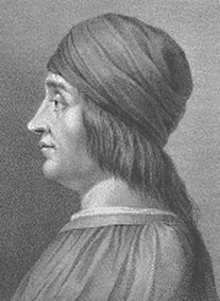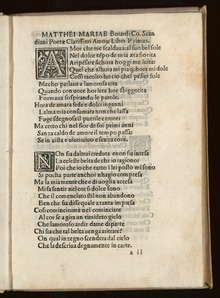Matteo Maria Boiardo

Matteo Maria Boiardo (
Early life
Boiardo was born in 1440,[2] at or near, Scandiano (today's province of Reggio Emilia); the son of Giovanni di Feltrino and Lucia Strozzi, he was of noble lineage, ranking as Count of Scandiano, with seignorial power over Arceto, Casalgrande, Gesso, and Torricella. Boiardo was an ideal example of a gifted and accomplished courtier, possessing both a gallant heart and deep humanistic learning.
At an early age he entered the University of Ferrara, where he acquired a good knowledge of Greek and Latin, and even of the Oriental languages. He was in due time admitted doctor in philosophy and in law.[3]
Career
Up to the year of his marriage to Taddea Gonzaga, the daughter of the Count of Novellara (1472), he had received many marks of favour from Borso d'Este, Duke of Ferrara, having been sent to meet Frederick III (1469), and afterwards visiting Pope Paul II (1471) in the train of Borso. In 1473 he joined the retinue which escorted Eleonora of Aragon, the daughter of Ferdinand I, to meet her spouse, Ercole, at Ferrara. Five years later Boiardo was invested with the governorship of Reggio, an office which he filled with noted success till his death, except for a brief interval (1481–86) when he was governor of Modena.
Writing
In his youth Boiardo had been a successful imitator of

Almost all Boiardo's works, and especially the Orlando innamorato, were composed for the amusement of Duke Ercole and his court, though not written within its precincts. His practice, it is said, was to retire to Scandiano or some other of his estates, and there to devote himself to composition, and historians state that he took care to insert in the descriptions of his poem those of the agreeable environs of his château, and that the greater part of the names of his heroes, as Mandricardo, Gradasse, Sacripant, Agramant and others, were merely the names of some of his peasants, which, from their uncouthness, appeared to him proper to be given to Saracen warriors.
Tarot
It is uncertain when Boiardo wrote a poem about a self-composed, unusual
References
- ^ "Boiardo". Merriam-Webster.com Dictionary. Retrieved 31 May 2019.
- ^ Matteo Maria Boiardo Archived 21 February 2009 at the Wayback Machine Letteratura.it
- ^ One or more of the preceding sentences incorporates text from a publication now in the public domain: Chisholm, Hugh, ed. (1911). "Boiardo, Matteo Maria". Encyclopædia Britannica. Vol. 4 (11th ed.). Cambridge University Press. p. 138. This further references Panizzi's Boiardo (9 vols., 1830-1831).
- ^ Chisholm 1911.
External links
- Works by Matteo Maria Boiardo at Project Gutenberg
- Works by or about Matteo Maria Boiardo at Internet Archive
- Boiardo's influence on the early Tarot game inclusive an extensive time line of Boiardo's life
